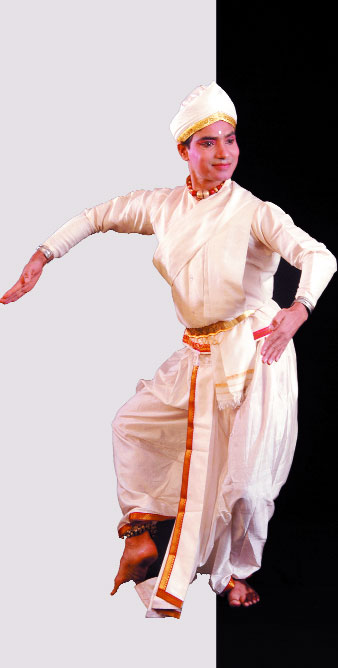BHANANANDA BARBAYAN, an internationally renowned exponent of Sattriya culture, speaks with SHALINI SAKSENA how he is taking a 600-year-old dance from Assam beyond the boundaries by performing the world over
We are all familiar with Bharatnatyam from Tamil Nadu, Kathak from Uttar Pradesh, Kuchipudi from Andhra Pradesh and Odissi from Odisha. But how many of us are aware of yet another dance form that is 600-year-olds and not just surviving but thriving and making waves in India and internationally as well?
Welcome to the world of Sattriya dance (pronounced Hottriya) from Assam and Dr Bhabananda Barbayan an internationally renowned exponent of this dance who has performed in France, Switzerland, Germany, Portugal and Bangladesh. Not only this, but he has also directed the music for eminent French filmmaker Emanuel Petit’s documentary titled Dans Les Drumes De Majuli, where he appeared in a number of sequences. He is a regular visiting faculty in Paris -VIII University, Kings College London besides being a Cultural Associate with Jawaharlal University Brown University, US and Drexel University, US.
He has been honoured with several awards — La Maison de Ananda Award 2012-13, Ustad Bismillah Khan Yuva Puraskar of Sangeet Natak Academy 2012 and Fellow of Neuron-Somatic Integration Programme.
He was just four when he started learning the art form from Uttar Kamalabari Satra under the guidance of gurus Paramananda Barbayan and Tuniram Barbayan (nritya), Cheniram Barbayan (khol bayan), Kamal Bargayan (gayan), and Baluram Bargayan and Gupiram Bargayan (oja). He was just 17 when he became the youngest Barbayan (one of the 12 cultural heads) of the Sattra.
He tells you that the dance was introduced in the 15th century by Sankar Dev, a Vaishnavnite saint, scholar, playwright, a social and religious reformer from Assam.
“The drama written by him are known as ankia naat and sattriya dance, at that time, was a part of it. The idea was to use dance as a medium of instructions that were mixed entertainment with devotion,†Bhabananda says.
The reason why this dance form, (now recognised as a classical art form by the Sangeet Natak Akademi in 2000), spread was because the State has over 900 satras — Vaishnavite monasteries — an initiative by the Ahom Kings in the 17th Century to promote neo-Vaishnavism in the region. As it was a place only for the monks the dance was only performed by the men.
“This dance form is dedicated to Lord Krishna. The dance can be classified into two styles — Paurashik Bhangi (tandava or masculine style) and Stri Bhangi (lashya or feminine style). It is an art form that is part of a prayer during ceremonies by the monks. It is performed thrice a day — morning, afternoon and evening. But as time passed, this dance is taught as an art form. When we perform on stage, the dance is designed into different parts like Guru vandana, Ram vandana, Geet abhinaya, Varnan, Shlokas (which doesn’t involve any dance) and the last is Melana, an elaborate dance form in its purest form,†Bhabananda explains and tell you that the influence of Lord Kirhsna spread due to Sankar Dev who traveled the whole of India.
“It was his influence that spread in the region. He was a staunch propagator of Lord Krishna and didn’t consider him as an incarnation of Lord Vishnu but that he is the supreme Lord,†Bhabananda tells you.
The dance itself has elements of masculinity due to strong Lord Krishna influence and the fact that it was solely performed by men; this included men dressing up as women to perform.
“There is a reason why this dance form is a so male-oriented. The satras consider Lord Krishna as the man. It was much later, in 1960s, that women were taught this dance form. Of course, they can’t perform inside the satras. They can only perform on stage as an art form,†Bhabananda says.
He tells you that the satras allowed woman participation in this dance form because they enjoy a lot of importance in the society.
“When the women started demanding that they too are taught this ageold art form, the satras agreed. The result is that it has brought in the grace and feminity to the dance. There are two types of Vaishnav monks in the satra; the kewalia bhakat or the celibate monks and then you have monks who can marry. Bhakti is about love for Lord Krishna. Hence, there is no conflict when it comes to teaching women,†Bhabananda tells you.
The costumes too are different. Each dance number has a different costume. The men wear dhoti, chaadar and paguri (turban). They wear jewellery too — Mata Moni — around the neck. The women wear ghuri and chaadar. The waist cloth which is worn by both men and women is called kanchi or kingkini.
“Traditionally, the costumes were of white or raw silk colour with the use of red, blue and yellow for specific dance numbers. Earlier, velvet and satin were mostly used for creating elaborate costumes. But times changed and as the dance evolved, so did the design and material for the costumes. Now, muga is used to make the costumes,†Bhabananda says.
The good part is that this dance form has many takers. “To begin with, not many were interested in learning this dance outside of the satra. But now that the dance has been recognised as a classical form, the younger generation is more open to learning it. Even though this form is relatively unknown outside of Assam, a lot is being done to promote it via dance festivals that are organised across the country. It is a beautiful dance as it comes with a message — how to develop bhakti, love for others and spirituality,†Bhabananda says.


























